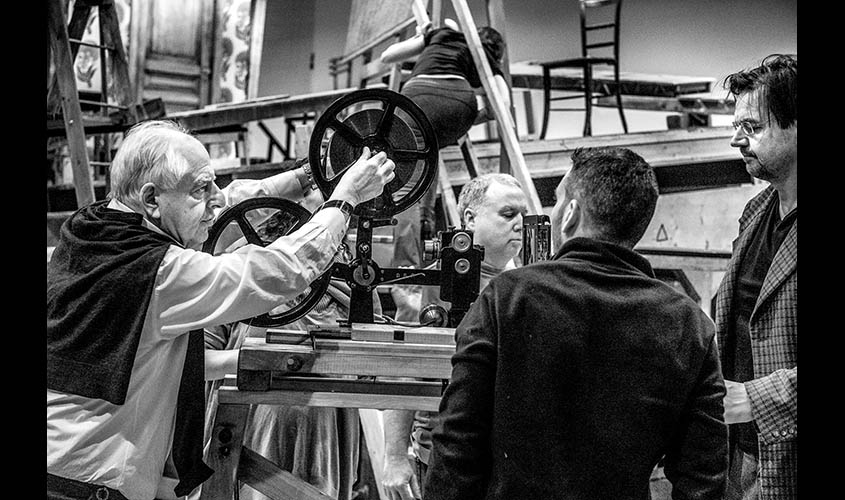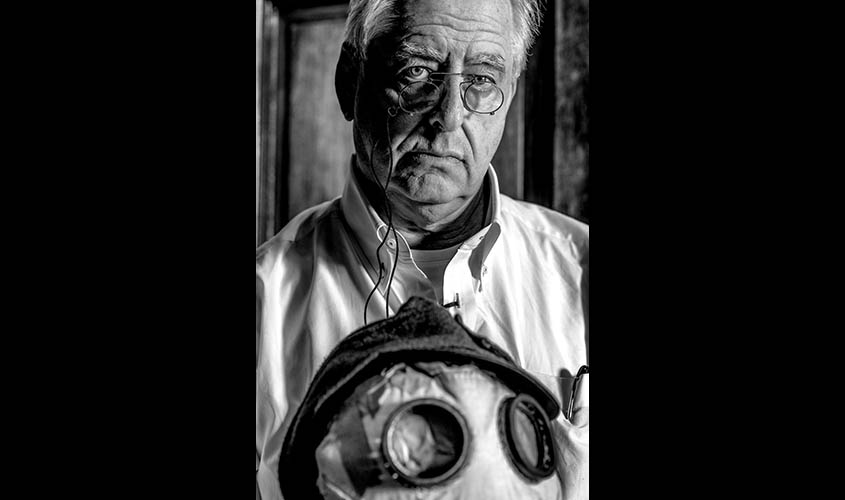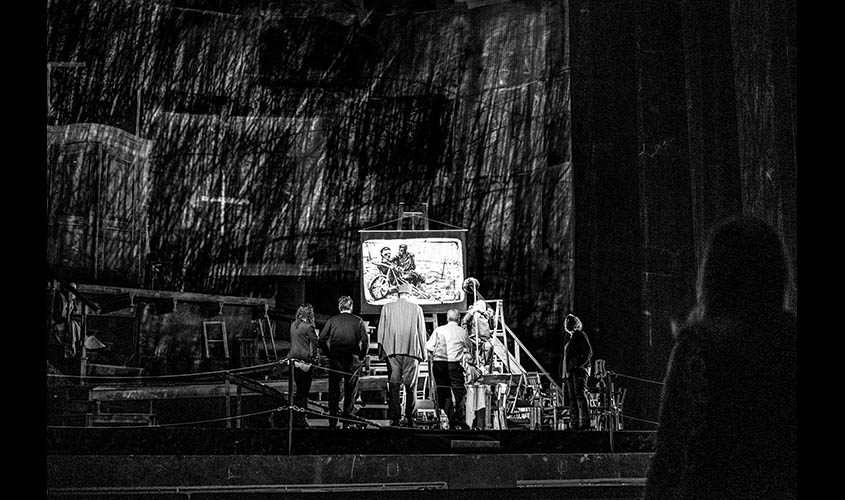Three years ago, on a trip to Johannesburg, I had the chance to watch artist William Kentridge working on a new production of Alban Berg’s knifelike opera Wozzeck. With a troupe of South African performers, Kentridge blocked out scenes from this bleak tale of a soldier driven to madness and murder—whose setting he was updating to the years around World War I, when it was written, through the hand-drawn animations and low-tech costumes that Metropolitan Opera audiences have seen in his stagings of Berg’s Lulu and Shostakovich’s The Nose.
Some of what I saw in Kentridge’s studio has survived in Wozzeck, which opens at the Met on Friday. But he often works on multiple projects at once, and much of the material instead ended up in The Head and the Load, a historical pageant about the impact of World War I in Africa, which New York audiences saw last year at the Park Avenue Armory.
Kentridge’s Wozzeck premiered at the Salzburg Festival in 2017. Zachary Woolfe of The New York Times called it “his most elegant and powerful operatic treatment yet.” At the Met, the Swedish baritone Peter Mattei will sing the title role for the first time; Elza van den Heever, like Kentridge from Johannesburg, plays his common-law wife, Marie; and Yannick N-Séguin, the company’s music director, will conduct.
Earlier this month, Kentridge was rehearsing Wozzeck in the deepest basement of the Met. Singers scampered and dancers staggered across a unit set that recalls a ruined building gashed by trenches, while the artist’s ashen, war-scarred drawings—intended for full-scale projection—appeared on a TV to the side. In a conversation afterward, he talked about the interwoven nature of his artistic practice, the contemporary resonance of World War I and the legacy of modernism in South Africa. Here are edited excerpts.
Q. Between Wozzeck, The Head and the Load and your staging of Kurt Schwitters’ Ursonate, you’ve been working on performances around the Great War for nearly four years. Is Wozzeck the one that structures them all?
A. Wozzeck was the first. Even though, in New York, Head and the Load was seen first, this Wozzeck was made before. There are a lot of things that we did with movement and dance that we could never use in Wozzeck, but we thought they were so interesting that we should find another space for them, which became The Head and the Load. Ursonate was kind of independent.
Q. When I was in Johannesburg, I watched you and the Wozzeck team stage a procession that, ultimately, ended up in the other performance.
A. The processions and also the dances in The Head and the Load both come from tests we did for Wozzeck. Each image takes its own shape, and they became two very different projects. But obviously, they overlap a lot in the language of the First World War, in the costumes, and in a style of acting that draws from the theater of the absurd, rooted in Büchner and in the Berg.
Q. The play the opera is based on, Georg Büchner’s Woyzeck, with its scenes of poverty, sex and madness, is very much the work of a young author.
A. He’s 23 years old when he’s writing it, in 1837, and doesn’t finish it before he dies that year. It’s first performed only in 1913. Berg sees it in Vienna in 1914.
Q. Berg is a young man then, too, about to be shipped off to fight for the Austro-Hungarian Army.
A. And I think he saw something of that in this expressionist play—it was seen in the context of expressionism when it was performed, first in Munich and then in Vienna. Even though the play was 80 years old, it had a kind of fractured nature. Büchner pictured things in the world as fragmentary, which is a very 20th-century feeling.
Q. The structure of the play is almost cinematic. And Berg’s libretto is quite faithful to that.
A. It has an episodic structure, with short images and scenes, that is so different from other theater pieces that had been written in the 19th century. For Berg, Büchner’s play offers a premonition both in its form and in its text, a premonition of the First World War. All the hallucinations that Büchner writes for Woyzeck are things that would never be seen in the 1830s but were literally there in the 1910s. Images of fire raging from earth to heaven, like the explosions of mines. Aerial views of the patterns that mushrooms make in the ground, which feel like a kind of aerial photography.
Q. The singers in this production are often walking across duckboards, like the ones in the trenches of Flanders. And the drawings projected behind them fix this production on the battlefield.
A. The blown-up churches and villages in the drawings are in Flanders. Lots of military maps, which are kind of a reflection of the chaos in Wozzeck’s head, as well as tying it to the landscape and the mapping of the war.
Q. Do you still work on these projections between two different studios?
A. A studio in my garden and a studio in Maboneng, where we have the Center for the Less Good Idea [a space for young artists working in experimental performance]. The drawings are done in the garden studio, and the maquette of the opera is there with a small-scale projector, so I can look at that with the technical team and the designers. Then, in the bigger studio in town, we do the workshops with 20 or 30 people, filming and projecting on a larger scale, to see what the projections look like with performers.
Q. Many years ago, you directed another adaptation of Büchner’s play: Woyzeck on the Highveld, a work of puppet theatre set during the first years of apartheid. Does that work inform this one at all?
A. No, that was a much more radical transformation: taking it out of the military context; making a private into an unemployed person; making the drum major a miner. It was very much set around Johannesburg. This is still set in Europe. But because it’s so fragmentary and so open, it’s a fantastic piece to work with, both the play and the opera.

Q. Well, the use of puppetry—you’ve made Wozzeck and Marie’s young son a puppet—was the other thing that made me think of the earlier work.
A. There’s always a problem: How do you deal with a child onstage? Do you have an 8-year-old pretending to be a 3-year-old? It’s always artificial, so I thought: Let’s do it full-on, where you know you’re looking at a piece of wood, and someone moving it, and you don’t have the anxiety. Will the child behave?
Q. Is it just a coincidence that the three operas you’ve done at the Met are all modernist, quite spiky scores?
A. That’s because I wouldn’t know what to do with the romantic, 19th-century opera score. I mean, I should be able to, but I just haven’t.
I suppose also that, while Lulu is certainly a vehicle for a great soprano, The Nose and Wozzeck are real ensemble pieces. Wozzeck is a gigantic, demanding role, but there’s a sense that people
Q. One central theme in The Head and the Load was how the colonial project shaped the development of European modernism, well beyond a surface borrowing of forms from Africa or Oceania. This Wozzeck seems to hint at that, too.
A. This Wozzeck is definitely inflected by the styles of movement and rhythms from the performers in Johannesburg—mainly black South Africans and also white—who participated in the workshop. And there’s also an openness on the part of those performers to finding out what the parts can be before they meet the singers who are going to do the role. Now, when you get a great singing actor like Peter or Elza, or Gerhard Siegel, that’s a treat—since even if you have a very set idea of a scene, within that shape, there’s so many things that evolve.
It’s a radical opera, also, in the sense that it feels, as you say, connected to colonialism. It takes the private, rather than the prince or the doctor or the captain, as the central figure. Its perspective is very much from the periphery.

Q. Many writers from South Africa and other postcolonial countries have written about the local or regional importance of modernism well into the 20th century, after artists in the west had condemned it as a formalist dead end.
A. I’ll tell you what it was: In South Africa, because the politics are so present, it was impossible to pretend politics didn’t exist. It meant one looked for strands of modernism that didn’t go in the direction of avoiding the figurative, the narrative, the political. So Russian constructivism, or the neue sachlichkeit in Germany, or Brecht—these were all ways of thinking about modernism in South Africa, rather than the route that Europe and America took toward abstraction and Jackson Pollock.
Those strands got ignored by the Greenbergian tradition in which I grew up, where painting was only about painting. It took a long time to unlearn that and to resurrect for myself other strands of figuration or thinking in narrative that weren’t a 19th-century way of doing it. So, in that sense, there’s a strong commitment to the heart of modernism, which had to do with the pleasure one can take in the fragmentation of society. To make fragmentation your subject, and revel in it, seems to me the heart, the core of modernism.
© 2019 The New York Times

